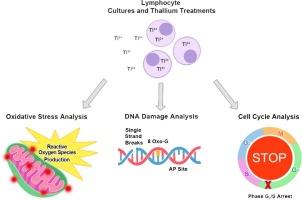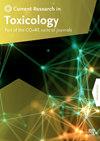铊(III)破坏细胞周期,诱导体外人淋巴细胞DNA氧化损伤
IF 2.9
Q2 TOXICOLOGY
引用次数: 0
摘要
铊(Tl)因其高毒性被认为对健康有害,并且是一种新兴的污染物,具有两种氧化态:Tl (I)和Tl (III)。然而,钛及其化合物的毒性可能受到金属氧化态的影响。Tl (III)是研究最少的Tl氧化态,尽管它可能影响细胞增殖并具有遗传毒性。因此,本研究的目的是分析TlCl3对体外人淋巴细胞细胞周期进程、DNA损伤诱导和氧化应激的影响。不同浓度TlCl3(0.1、0.5、1、5、10和50 μg/mL)处理不同时间(1、3和24 h)后,细胞活力没有变化,只有高浓度TlCl3(10和50 μg/mL)处理72 h后,细胞活力减少。5 - 50 μg/mL TlCl3处理48和72 h后,细胞停滞在G1期。此外,TlCl3通过激活甲酰胺嘧啶DNA糖基酶(FPG)来增加DNA损伤,FPG氧化DNA碱基并增加活性氧的产生。综上所述,TlCl3通过氧化DNA碱基诱导氧化应激和DNA损伤,可能破坏细胞周期。本文章由计算机程序翻译,如有差异,请以英文原文为准。

Thallium (III) disrupts the cell cycle and induces oxidative DNA damage in human lymphocytes in vitro
Thallium (Tl) is considered hazardous to health because of its high toxicity and is an emerging contaminant with two oxidation states: Tl (I) and Tl (III). However, the toxicity of Tl and its compounds can be influenced by the oxidation state of the metal. Tl (III) is the least studied oxidation state of Tl, although it may affect cell proliferation and has genotoxic potential. Therefore, the aim of the present study was to analyze the effects Tl (III) chloride (TlCl3) on cell cycle progression, the induction of DNA damage, and oxidative stress in human lymphocytes in vitro. There were no changes in cell viability after treatment with different concentrations (0.1, 0.5, 1, 5, 10, and 50 μg/mL) of TlCl3 for different exposure durations (1, 3, and 24 h), and a reduction in the number of viable cells was observed only after treatment with high concentrations (10 and 50 μg/mL) for 72 h. In addition, cells treated with 5–50 μg/mL TlCl3 for 48 and 72 h arrested in G1 phase. Moreover, TlCl3 increased DNA damage by activating the enzyme formamidopyrimidine DNA-glycosylase (FPG), which oxidized DNA bases and increased the production of reactive oxygen species. In conclusion, TlCl3 induces oxidative stress and DNA damage by oxidizing DNA bases, which may disrupt the cell cycle.
求助全文
通过发布文献求助,成功后即可免费获取论文全文。
去求助
来源期刊

Current Research in Toxicology
Environmental Science-Health, Toxicology and Mutagenesis
CiteScore
4.70
自引率
3.00%
发文量
33
审稿时长
82 days
 求助内容:
求助内容: 应助结果提醒方式:
应助结果提醒方式:


